Benefits
• Improves circulation and can reduce hypertension (high blood pressure)
• Balances thyroid and parathyroid glands
• Helps treat female reproductive disorders
• Helps manage asthma
Contraindications
• Some chronic neck problems
• Migraine
• Mensuration
• Extreme hypertension
Intro
Intro
I have great sympathy for students who struggle with Salamba Sarvangasana (Shoulderstand) . Because of an old neck injury, Salamba Sarvangasana used to be quite difficult for me. My neck and upper back ached in the pose and throbbed for several minutes after I came out of it. About twice a year I would strain muscles in my upper back while practicing Shoulderstand. I sought the advice of teachers, who all came to my aid by adding more and more props. Before long, my Shoulderstand was supported by four blankets, a belt tied around my upper arms, and a chair positioned under my hips.
One day, surrounded by these accoutrements, I took stock of my situation and realized that while the outer form of my pose would pass muster, I had no insight whatsoever about how to actually do Shoulderstand! Like a tree with shallow roots, I had to be propped up in order to stand at all.
My predicament begged the question: How were the props helping me? Though the many blankets did reduce my level of discomfort, after much reflection I concluded that props must also give guidance and understanding so they can eventually be discarded. In other words, props are not meant to be just a crutch. Mine were, so I threw them away–except one blanket and a wall, which I used for support until, after a couple of years, I educated and strengthened myself enough to perform the actions needed to do Shoulderstand unassisted.
Knowing that I am not alone in struggling with Shoulderstand, I share my story because I hope it encourages you to persevere in seeking a solution to any problems you may encounter in this important inversion. Most often called "the mother of asanas," Shoulderstand is a potent pose that should be an integral part of almost every serious student's asana practice.
Inversions like Shoulderstand are so powerful because, as earthbound creatures, we are so strongly affected by the long-term impact of gravity. Over the years our bodies begin to, well ... sag. This decline is clearly visible in our skin, but there are much more important unseen consequences to gravity's relentless drag. After years of combating gravity, all the organs, especially the heart and the rest of the circulatory system, grow sluggish, which results in less nourishment to our cells and leaves us vulnerable to heart disease, fatty deposits in the blood vessels, varicose veins, and other effects of aging.
Though the effects of gravity are inevitable, we can do a great deal to counteract its impact. Like the original yogis, we can cleverly beat gravity at its own game by turning the body upside down. This simple action benefits the whole body. No wonder the early yoga masters stressed the importance of inversions and said Headstand and Shoulderstand could conquer old age!
Demonstrations
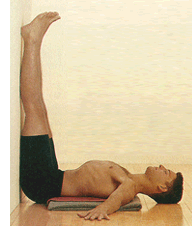
1. Viparita Karani
Fold a firm blanket into a rectangle at least 24 inches by 20 inches. Place it on a sticky mat, folding about a foot of the mat over the folded edge of the blanket so you will have traction for your elbows when you eventually come into Shoulderstand. Place the blanket about 68 inches away from a wall, folded edge toward the center of the room, and lie down on the blanket so your shoulders are on the folds, your hips are near the wall, and your legs extend straight up it. Stretch your arms out to your sides just below shoulder level. Relax your neck and root the center of the back of your skull into the floor, feeling the opening of your chest and throat.
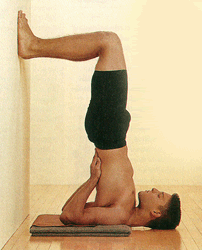
2. Wall-Supported Shoulderstand
From the position in Figure 1, press your heels into the wall, bend your knees, and lift your hips to bring yourself onto your shoulders. You may need to wriggle your shoulders toward the wall to keep them on the edge of the blanket. Pause at this point to again root the center back skull and open your throat. Join your hands behind your back and exhale to straighten your arms, pressing your elbows down as you bring your hands to the floor. With each exhalation, lift your collarbones and ribs away from your throat. Moving slowly, lengthen the backs of your arms, rotate your outer arms toward the floor, and bend the arms to place your hands on your upper back.
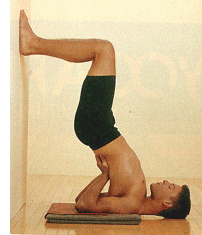
3. Viparita Karani Mudra
Using your hands as a fulcrum to keep your rib cage in a near-vertical position, drop your hips slightly back toward the floor. Your spine will arch a little, lengthening your front body. To intensify this uplift, consciously open your throat and upper chest with each inhalation and continue to ground your center back skull and elbows and lift the sternum with each exhalation.
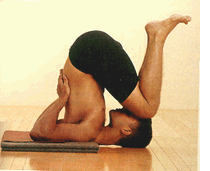
4. Knees to Forehead
Be diligent about keeping your wight grounding through the center back skull and elbows as you bring your knees down and rest them on your forehead. Let the weight of your knees assist in rooting the center back skull. Relax your hips toward your feet to stretch your back, lengthening it away from your neck and bringing your rib cage closer to vertical. Don¹t drop your chin; instead, keep your throat open, lifting the sternum toward your chin with each exhalation.
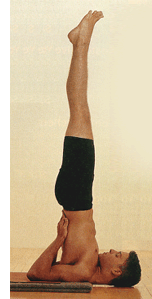
5. Salamba Sarvangasana
From the position in Figure 4, inhale to lift your knees and then use your exhalation to extend your body upward from the point where the sternum and chin meet, bringing your legs straight up and balancing your feet over your shoulders. Keep your weight evenly distributed between your skull and elbows, pressing the center of the back of your skull into the floor if necessary. Lengthen your tailbone up away from the spine and extend the backs of your legs. This pose can be held as long as you can continue to lift your chest. To come down, place your feet on the wall and slowly roll your spine to the floor.
Saving Your Neck
Saving Your Neck
Salamba Sarvangasana entails a whole lot more than just flipping upside down on your shoulders. What makes it so difficult? In two words: the neck. But there is no reason to avoid Shoulderstand just because you are prone to neck problems. In fact, if you practice Shoulderstand properly, it can strengthen your neck. If you do have chronic neck problems, I advise working with an experienced teacher who can give you skilled instruction. Opinions will always differ about whether Shoulderstand should be practiced with the support of multiple yoga props; certainly my opinion has evolved from my own experience with Shoulderstand. Learn all you can from your teachers, but remember that in the end the decision about what props to use in your regular practice is by rights yours and yours alone.
Regardless of the health of your neck, regardless of whether you use many blankets or none at all, a slow and patient approach to Shoulderstand is worthwhile; a poorly practiced Shoulderstand can aggravate or cause neck problems. I recommend a Shoulderstand strategy that starts with Viparita Karani (Legs-Up-the-Wall Pose) and gradually trains you to rely more on spinal strength than on props to support your Shoulderstand.
Prepare for Viparita Karani by folding a firm blanket into a rectangle large enough to fit comfortably under your torso from shoulders to hips (at least 24 inches by 20 inches). Place it on a sticky mat, folding about a foot of mat over the folded edge of the blanket so you'll have traction for your elbows.
Position the mat and blanket just far enough from a wall that you can lie on it with your shoulders on the blanket fold and your hips near the wall. Lie down on the blanket with your legs up the wall and your arms stretched out at shoulder level on the floor. With your eyes closed, consciously relax into the blanket. Take your time; let Viparita Karani be an exercise in patient undoing. Feel your shoulders and the back of your skull melting into the floor each time you exhale. As tension dissolves, you may feel more freedom in your neck, perhaps allowing you to elongate it a bit.
Don't just tuck your chin in; wriggle both the front and back of your neck longer until your weight rests on the center of the back of the skull. Allow your face to become quiet and feel how you can turn your head easily from side to side. As you relax, your breathing will become slow and steady and create a delicate sound in the throat. There is no need to force this sound; simply shifting your attention to the movement of the breath in the throat will usually produce this subtle sound. The sound and accompanying sensations are a bit like sonar, helping you map and maintain the space you seek, the whole way from the soft palate to the upper chest.
You are now ready to raise your torso off the floor. Exhale and gently press the center back skull (not the base of the skull) into the floor. Do you feel the response in your neck muscles? What you are doing is creating an active cervical arch that will help avoid overstretching the neck and begin the movement that will be the source of core support for your Shoulderstand. This movement is quite important, but don't do it by pushing the chin up: That action overarches the neck.
Keep the center of the back of your skull firmly rooted to the floor and exhale as you bend your knees, press the soles of your feet into the wall, and roll up onto your upper back or shoulders. Allow each exhalation to add strength to your lift. Regardless of how high you rise onto your shoulders, it is important that you maintain the active cervical arch of the neck. If you feel that your chin drops or your neck flattens down, intensify the action of pressing the skull into the floor.
Next, bring your arms behind your back, join your hands, extend your arms toward the wall, and press your elbows down far into the blanket. Please don't actively squeeze your shoulder blades together, since this may constrict your neck. Instead, allow the action of the arms to narrow the shoulder blades more gently. If you are prone to hyperextending (i.e., locking) your elbows, bend them enough that you can press them down into the blanket. If, on the other hand, you can't bring your elbows to the floor at all, lean back until you can root them firmly into the blanket. Then lengthen the back of your arms and bend your elbows, placing your hands on your back as close to the shoulder blades as possible.
If your elbows start to splay out wider than the width of your shoulders, lower your arms. Moving more slowly, strongly lengthen the backs of your arms and rotate your outer arms toward the floor as you once again bend the arms to place your hands on your upper back. If your elbows don't splay open, leave well enough alone.
Now begin to release your front shoulders toward the floor; feel as though they melt down over the tops of your shoulders. This movement will roll you higher onto your shoulders, but it must remain secondary to the more important actions of planting your elbows and the center back skull. Rooting the center back skull and elbows creates a critical rebound effect that serves as the basis for Jalandhara Bandha (Chin Lock), which in turn provides the internal lift crucial for a good Shoulderstand.
Engaging Internal Support
Engaging Internal Support
Without Jalandhara Bandha, Shoulderstand lacks its essential foundation. Bandhas are used in asana and pranayama to contain and direct the prana (life energy) generated by those practices. In Shoulderstand, Jalandhara Bandha is used to regulate the flow of prana, especially to the heart, throat, and head. Unfortunately, older yoga texts describe the action of Jalandhara Bandha in simple terms that give no hint of how difficult it actually is. In the Hatha Yoga Pradipika , for instance, a medieval text considered to be the oldest in-depth treatise on hatha yoga, Swami Svatmarama simply instructs students to "Contract the throat and press the chin against the breast."
The proper action is much more difficult than that, but if you root your center skull and elbows strongly enough, you may feel a hint of the necessary lift. Indeed, without the lift these actions provide, you may have your chest and chin pressed together and yet still find the body descending painfully–and dangerously–onto your neck. Surely that's not what Swami Svatmarama had in mind!
I have become very fond of a variation of Shoulderstand called Viparita Karani Mudra (Upward Action Seal). Usually students can get a sense of the action of Jalandhara Bandha and avoid overstretching the neck in this pose more easily than in full Shoulderstand.
It's easy to move into Viparita Karani Mudra from your position in Shoulderstand with your feet on the wall. Keeping your feet on the wall and supporting your rib cage with your hands, lift as high as possible onto your shoulders. Then, using your hands as a fulcrum to keep the rib cage fixed in its near-vertical position, drop your hips slightly backward toward the floor. Your spine will arch a little, lengthening the front body from throat to pubis.
Continue to root your head and elbows to maintain an active cervical arch. Then, to intensify the uplift that creates Jalandhara Bandha, consciously open your throat and upper chest with each inhalation; with each exhalation, ground your center back skull and elbows and let a strong breath-sound from the throat lift your ribs, drawing your top breastbone closer to the chin, perhaps even bringing them into contact. Be careful not to drop your chin, since that movement may overstretch your neck. As the breastbone and chin merge, energy is generated within the throat that channels up through the torso, creating an infrastructure that supports the asana from within.
Once you've engaged the bandha, you may sense a strong current rising from your throat and traveling up the spine. In their book Dancing the Body of Light (Pegasus Enterprises, 1999), Dona Holleman and Orit Sen-Gupta give a good explanation of this phenomenon: "The combination of rooting and constricting the energy toward the center creates the 'eye' of the storm; in other words, the energy is lifted and the energy shoots upward." Gently arching your spine in Viparita Karani Mudra may make it easier for you to engage this upward energy, enabling you to lift: first from the chest into the midbody, opening your lower ribs, and then into the abdomen, helping the pubic bones curve away from the navel. When the entire spine is nourished by this upward energy, the pose becomes more comfortable and effective.
All of the bandhas intensify the cleansing effects of hatha yoga. According to traditional yogic understanding, a fire called agni , located just below the navel, cleanses the body by burning away toxins. When the flow of energy throughout the body is disrupted, the lower body accumulates excess apana , the downward flowing energy responsible for elimination. This excess contributes to weak breathing, lethargy, poor elimination, and other ailments. Inverted asanas turn the flame of agni toward this waste, enabling us to burn it off more efficiently. Inverting is beneficial in and of itself, but you should focus on your exhalation because the cleansing is most effective when the exhalation is longer than the inhalation.
Since supporting your feet on the wall helps you lift and maintain an active cervical arch, I encourage you to just stay in supported Viparita Karani Mudra if maintaining Jalandhara Bandha is very challenging. However, if you feel strong enough to take your feet off the wall, give it a try. Keep the slight bend at the hips as your feet leave the wall; once you've straightened your legs, position your feet over your shoulders.
Of course, you will immediately feel the added weight you now bear. In response, increase the power of your exhalation as needed to maintain your lift. If your neck presses into the floor or your chin drops, please put your feet back on the wall. The actions required to retain the cervical arch, to create Jalandhara Bandha, and to lift the spine are much more important than taking your feet off the wall. Give yourself permission not to proceed to full Shoulderstand if you feel a supported pose is more appropriate for you. Rest assured that you are still receiving the powerful benefits of inversion. On the other hand, if you feel quite strong in Viparita Karani Mudra, let us move toward full Shoulderstand.
Beginning in Viparita Karani Mudra, exhale as you bring your knees down, placing them on your forehead in a variation of Karnapidasana (Knee-to-Ear Pose). The ability to put your knees on your forehead while maintaining an active cervical arch is an excellent indicator of whether you can safely perform full Shoulderstand. (If you are unable to rest your knees on your forehead and keep an active cervical arch, return to Viparita Karani Mudra with your feet on or off the wall.)
In this Karnapidasana variation, let the weight of your upper legs and knees sink into your forehead to enhance the rooting of your skull. Spend some time in this pose, allowing it to gently stretch your back muscles and elongate your spine as you slowly continue to bring your rib cage closer to a vertical position. Help ensure that you don't overstretch your neck or let your chin drop by continuing to strongly plant the elbows and maintaining the upward movement of energy from within the throat. You should feel this lifting motion become even stronger in response to your efforts in Karnapidasana. You may also find that you can move your hands a bit closer to your shoulders and manually lift the ribs. Keeping your rib cage in the same position, inhale to raise your knees from your forehead and exhale to extend up into Salamba Sarvangasana.
In this classic version of Shoulderstand, primary support still continues to come from the upward push created by Jalandhara Bandha, which in turn depends on rooting the center of the back of the skull and the elbows. As your ribs lift off the throat, your breastbone will lift toward, and possibly touch, the tip of your chin. Remember, the chest travels to meet the chin (not the other way around). Even when the chest and chin come together, make sure the chin doesn't drop; you must continue to generate so much core lift that your spine remains taller and stronger along its entire length. Without enough upward movement, the front lower ribs tend to cave in and the entire pose weakens, possibly causing stress to your neck.
Take a close look to see if your pose suffers from this common problem. Examine your lower ribs. If they are sinking back into your body, you can try a couple of remedies. First, recall the slight back arch you did in Viparita Karani Mudra. Using your hands to keep your rib cage fixed, drop your hips back just enough to restore length to your front body. Also, use your legs and abdomen more strongly. While Jalandhara Bandha really creates the primary lift, your abdomen and legs must also play an important role in lifting your Shoulderstand. Tap into that support, softening your front thighs and drawing your groins into your pelvis on your inhalation; on your exhalation, lengthen the tailbone away from the spine and extend the backs of your legs.
This action will generate length and internal support for your lumbar spine as well as a feeling that the legs are helping to hold you completely upright in the pose, thus sustaining a sense of comfort. Though you do need strength to sustain and stabilize the uplift in Shoulderstand, you should feel no strain at all. As always, your breath is a good guide to the overall health of your asana. The sound of the breath should remain subtle and steady, with each exhalation strong and at least as long as the previous inhalation. If you feel strain or cannot sustain a breath-initiated uplift, put your feet on the wall or return to Viparita Karani Mudra. If not, remain in Shoulderstand, continuing to refine the pose.
Deepening the Subtle Effects
Deepening the Subtle Effects
In any asana, physical sensations and techniques often dominate your attention. When a pose is difficult, as Salamba Sarvangasana can be, it is easy to rush through the pose.
Shoulderstand needs time to take shape and make its effects felt. As your actions work their way to the core of the body, the benefits of the asana deepen dramatically. If unhurried, your body will continue to change, allowing a natural and lasting expansion of your range of motion. For example, as your shoulders adapt to the deep rotation required for this pose, you may be able to move your hands closer and closer to your shoulders, which in turn helps you to achieve greater lift and ease in the whole pose.
Also, while the effects of Salamba Sarvangasana (like any asana) are most noticeable in the surface muscles of the body, subtle but powerful internal movements inevitably ripple through you as you hold the pose. Establish a comfortable balance that allows you to prolong the pose in attentive stillness for several minutes, so you can explore these subtle inner currents. Search out pockets of inner tension, letting the breath's pulsating rhythm help restore space and movement in the deepest regions of the body.
Of course, the optimum length of time to hold any pose is unique to each person–unique, in fact, in every practice session, depending on the condition of your body on a given day. I'm not a big fan of forcing the body to hold a pose for a predetermined time. When you impose a fixed time, you can easily outstay your welcome in Shoulderstand and open the door to injury. But eventually, if you want to fully enjoy the effects of inversion, you should try to build up your Viparita Karani Mudra or full Shoulderstand until you can practice them for at least three to five minutes.
To come out of either pose, put your feet on the wall and slowly curl back to the floor. Lie on your back for a minute. You should expect to feel as though your neck has been stretched, but any discomfort should be mild and subside quickly. If it doesn't, I suggest practicing for a shorter length of time or switching to Viparita Karani Mudra with your feet on the wall instead of full Shoulderstand.
Now that the mild constriction of Jalandhara Bandha has been released, all the energy you built up in your throat is also released, which can bring a wonderful sense of expansion through your chest and throat. After relaxing for a minute, roll over on your side and come to a straight-back sitting position. If you feel a strong lift through your upper back and your skull seems to be floating gently upward, you have sure signs that your Shoulderstand did its job.
The early yogis described the potent effects of this inversion with metaphoric language: locks (bandhas), seals (mudras), inner fire (agni), upward and downward winds in the body (prana and apana, respectively). Rather than the objective, analytical language now used by science, the yogis' terms reflected their personal subjective experiences and were meant to evoke similar self-discoveries in their students. No matter how much our modern, Western minds are attracted to analysis and explanation and no matter how helpful such knowledge can be, it can never replace the experience of self-inquiry and rejuvenation that results from practice.
In Salamba Sarvangasana, as in all hatha yoga, much of the beauty of practice lies in knowing that while each of us walks respectfully in the footprints of the masters who have gone before, we must each use our own unique body to continue the journey. Only the whole-hearted, authentic inquiry of each individual practitioner keeps Shoulderstand a living entity–and keeps hatha yoga a vital tradition, venerable and yet ever unfolding.
Barbara Benagh has been practicing yoga since 1974. She is grateful to her first teacher, Elizabeth Keeble of Birmingham, England, for igniting her passion for yoga. Barbara teaches seminars throughout the United States and has a particular fondness for her school, The Yoga Studio, in Boston, and for the devoted students there.